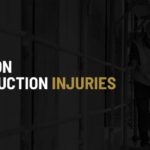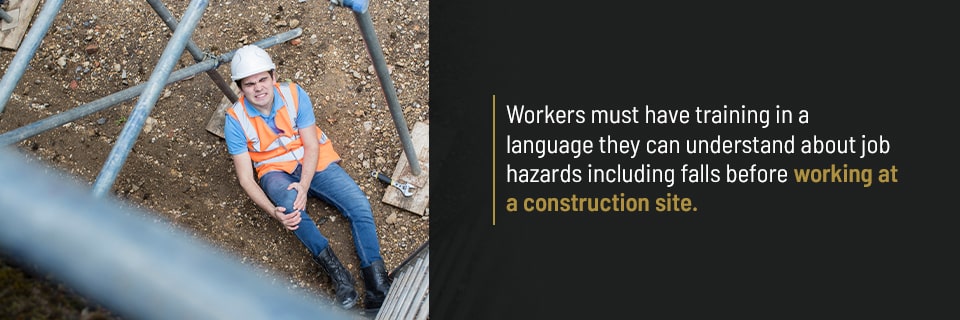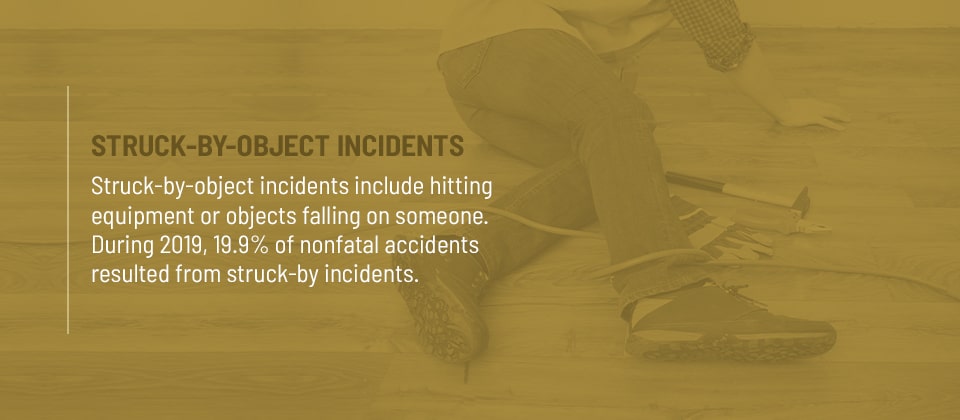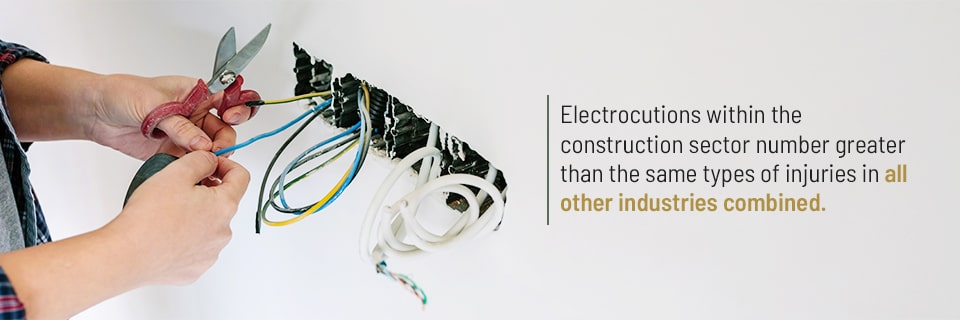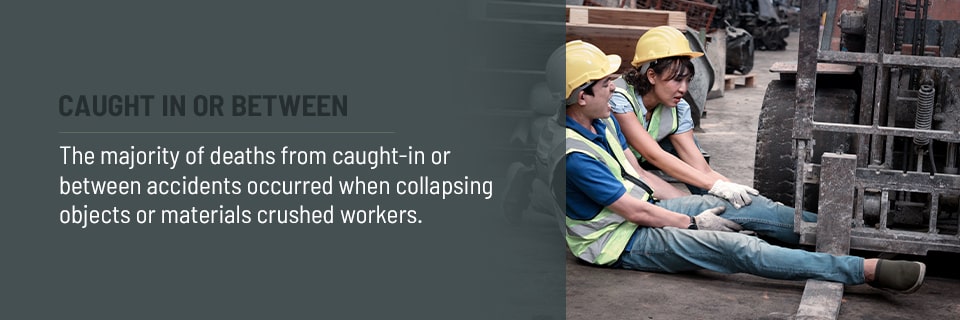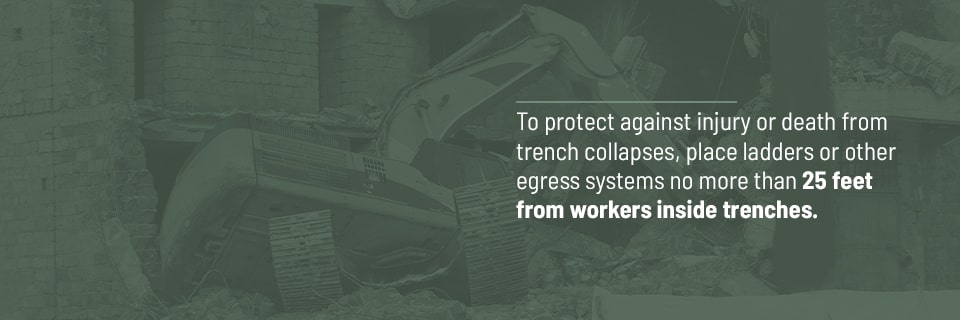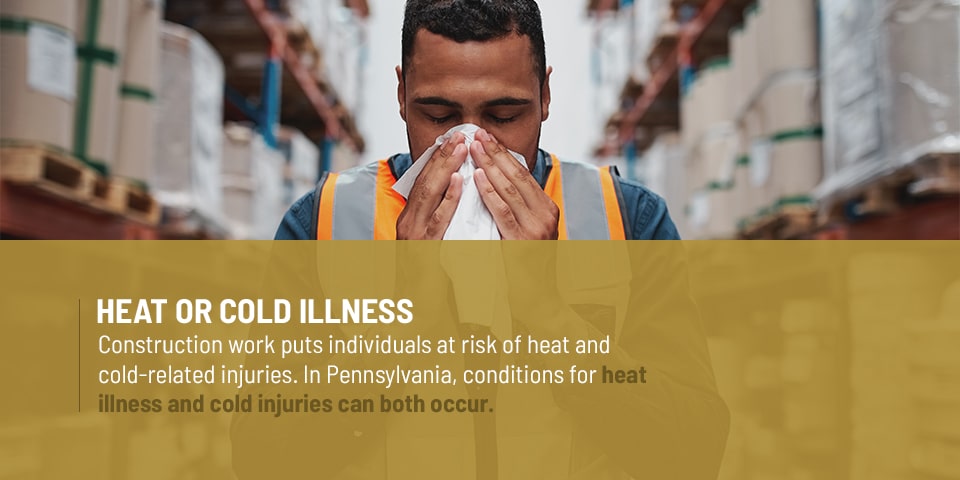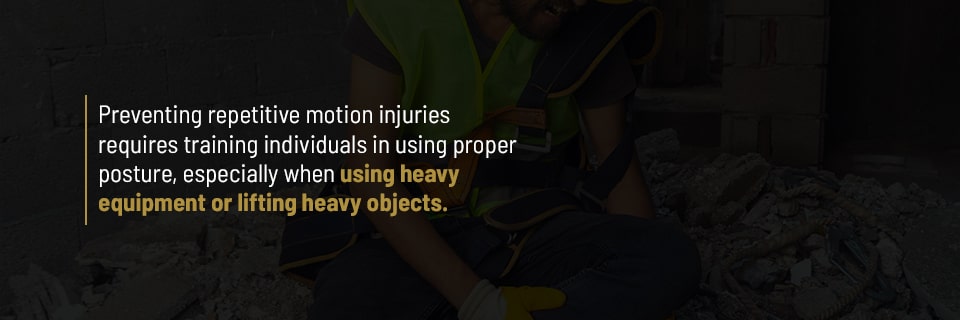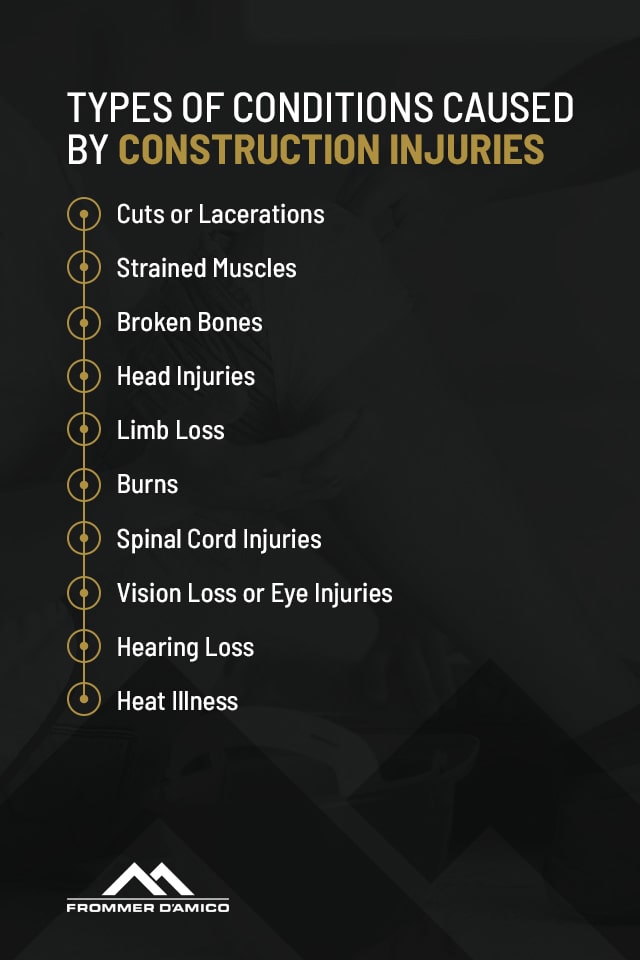7 Common Construction Injuries
Working in the construction industry carries inherent risks. To protect individuals from harm, the Occupational Safety and Health Administration (OSHA) has strict safety guidelines for job sites. Workers can face serious injury when construction companies fail to meet all these occupational safety regulations. When neglect or human error results in injury, those harmed should seek legal advice for possible compensation.
Common Construction Worker Injuries
Construction incidents cause injuries and fatalities each year. OSHA cites the top four causes of fatalities as falls, struck-by-object incidents, electrocutions and caught in or between objects. Injuries in the construction industry, while declining, are still 29% higher than reported injuries in all other sectors combined. These injuries include the top four fatality causes, plus trench collapse, burns and overuse injuries.
1. Falls
Fall accidents include falling from a height to a lower level or slipping and falling on the same level. Fall injuries in 2019 accounted for 31.1% of nonfatal construction injuries.
OSHA requires employers to provide fall protection measures at or above heights of 6 feet for construction workers or at any height near dangerous equipment. These fall prevention methods include using floor hole covers or railings with toe-boards, stair railings, safety lines with harnesses, fall nets and handrails. Redundant safety features, such as harnesses and railings, reduce injuries from falls.
Employers must also keep floors as clutter-free and dry as possible to prevent trip or slip incidents. Workers must have training in a language they can understand about job hazards including falls before working at a construction site. Not meeting these standards may lead to worker injury or OSHA citations.
OSHA reported failure to protect against falls in the construction industry as the top-cited issue in 2020. Failure to meet fall protection training ranked as the eighth most-cited standard during the same year.
Scaffolding and ladder safety can prevent falls. The fourth and fifth most-cited OSHA standards across all sectors were scaffolding and ladder use in the construction industry in 2020. Four of the top 10 most-cited OSHA standards in 2020 involved fall prevention. These citations explain why falls rank among the top causes of fatalities and nonfatal injuries for construction.
2. Struck-By-Object Incidents
Struck-by-object incidents include hitting equipment or objects falling on someone. During 2019, 19.9% of nonfatal accidents resulted from struck-by incidents. Adding struck by to caught in-between, the total of contact-with-objects nonfatal injuries accounted for 32.8% of nonfatal injuries. Contact-with injuries ranked as the top cause of nonfatal incidents.
The two types of struck-by incidents have different methods of prevention:
- Falling object protection: To protect against head injuries from falling objects, workers must wear hard hats in specified areas. Eye protection prevents falling or flying objects from damaging the eyes. Workers must also avoid standing beneath suspended items. Those working at heights on scaffolding or roofs should secure tools and equipment to prevent them from falling. At ground level, secure stacked containers to prevent them from falling onto individuals.
- Struck-by prevention: Struck-by equipment incidents may occur due to the injured or the equipment operator not noticing potential danger. Workers should never stand between stationary objects and moving equipment. They should also wear brightly colored clothing to make themselves more visible to equipment operators. Operators must look for pedestrians in the area before moving equipment. They should avoid driving equipment in reverse without a spotter behind them to verify the area is clear of people.
3. Electrocution
Electrocution injuries are in the top four causes of fatalities but do not rank among the top five nonfatal incidents. This difference in rankings indicates how dangerous electrocution injuries are. Electrocution can cause nerve damage, cardiac arrest, burns and muscle contractions. These types of damage can be severe or fatal in many cases.
Electrocutions within the construction sector number greater than the same types of injuries in all other industries combined. Construction general contractors and workers must take safety measures to prevent this common type of accident on job sites. Maintaining a safe working environment, training workers on electrical safety and using safe equipment can reduce the incidence of electrocutions in construction.
The most common cause of electrocutions, indirect or direct contact with live current, accounts for more than half of cases. Often, these cases happen from violations of safety standards. All workers on a construction site need training for safety around electricity. Many fatal electrocutions occur in nonelectrical specialists. Training contractors, construction workers and other laborers on the job site to work around electricity can prevent electrocutions caused by a lack of knowledge of safe work practices.
Workers must know where utility lines are located on job sites when operating equipment, using metal ladders or working on scaffolding or roofs. They must maintain safe distances from power lines at all times. Before servicing electrical equipment, workers must follow lockout and tag-out practices to ensure the device does not have an electrical charge. Failing to meet these requirements for lockout and tag-out procedures ranked as the sixth most-cited OSHA violation.
When using portable electrical tools, workers should ensure the devices have double insulation or are grounded. For nonportable tools, plugging into ground-fault circuit interrupter outlets protects against electrocutions. All extension cords and plugs used for electrical equipment need to be fully intact without frayed insulation or damage. Replace the equipment if it shows signs of wear.
4. Caught in or Between
Injuries caused by individuals being caught in or between objects occur when someone gets trapped. They may be crushed beneath fallen items, caught in machinery or pressed between a wall and equipment. Possible injuries from these situations include crushing, broken bones, lacerations or loss of body parts. Fatalities from caught in or between injuries accounted for 5.4% of the “Fatal Four” causes of death in construction.
The majority of deaths from caught-in or between accidents occurred when collapsing objects or materials crushed workers. This type of caught-in or between incident accounted for more than two-thirds of the deaths in this category. The remaining third died from being crushed or caught in equipment.
Workers must have the training to avoid placing themselves between moving and immobile objects. Plus, they must always remain aware of their surroundings. Employers also have a responsibility to place barriers around moving parts and machinery to protect workers from injury.
5. Trench Collapse
When the sides of a trench fall in on themselves, workers inside become trapped and can sustain crushing injuries or suffocation. One cubic yard of dirt weighs up to 3,000 pounds. When dirt collapses on workers in a trench, it can cause severe injury or death.
Deaths from trench cave-ins averaged 35 per year from 2000 through 2009. OSHA reviews of these incidents found not having appropriate protective systems in place caused most of the deadly collapses. OSHA requires trenches of 5 feet deep or greater to use one of the following protective systems — trench shields, sloping the ground, shoring the trench with supports or benching the ground.
To protect against injury or death from trench collapses, place ladders or other egress systems no more than 25 feet from workers inside trenches. Work sites should have a competent person to inspect trenches before, during and after use and alert workers of potentially dangerous conditions. Workers must also watch out for signs of failure of the protective system and leave the trench immediately if they notice any.
Trench collapses rarely provide any warning for those working in the trench. Responsible monitoring of the trench conditions can identify building dangers and alert those in the trench to leave. With protective systems in place and careful monitoring of the trench, injuries and deaths are preventable in most cases.
6. Heat or Cold Illness
Construction work puts individuals at risk of heat and cold-related injuries. In Pennsylvania, conditions for heat illness and cold injuries can both occur. OSHA does not have specific standards for protecting against heat and cold stress. Employers still have an obligation under the OSHA general duty clause to provide workers a safe environment, free from hazards that could cause serious injury, illness or death. These hazards include heat and cold.
Summer sun and high temperatures can induce heat stroke or heat illnesses in those working on job sites. More than one-third of all heat-related deaths in U.S. occupations occurred in construction workers, totaling 285 between 1992 and 2015. While employers typically don’t count heat-related illnesses, a study from North Carolina showed that they were the reason behind more work-injury trips to the emergency room than other causes. Secondary injuries caused by heat can occur when workers lose grips on tools from sweat, feel dizzy from heat exposure or cannot quickly respond to hazards. Injuries on construction sites increased 0.5% per 1 degree C increase in heat index value per a Washington study.
Heat illnesses start with heat cramps, progress to heat exhaustion and can lead to heatstroke. Workers experiencing cramping, dizziness, fainting, nausea or excessive sweating may have heat exhaustion or heat cramps. These conditions occur from excessive temperatures. Immediately removing the worker with these symptoms to a cooler location and rehydrating them can prevent heatstroke.
Heatstroke is potentially fatal and an emergency. The individual’s body temperature rises to extreme levels, they may have dry skin, lose consciousness or have seizures. Cooling off the individual is not enough in cases of heatstroke. They need someone at the job site to call 911 to get them safely and quickly to a hospital.
Cold stress and injuries can occur during cooler months. Freezing conditions are not required for workers to have a risk of cold injuries. Trench foot and chilblains can cause permanent damage at temperatures of 60 degrees Fahrenheit or lower. Trench foot causes skin tissue to die when feet stay wet and cold because wet feet lose heat 25 times faster than dry ones. Chilblains cause permanent capillary bed damage that can produce redness and itching with future cold exposure. More serious cold threats include frostbite, which could lead to amputations, and hypothermia, which can kill. Cold injuries require immediate action to prevent permanent damage, loss of body parts or death.
Employers must monitor all workers throughout the year for signs of heat or cold illness, provide them with ways to prevent these conditions and request emergency treatment when required.
7. Overuse Injuries
Repetitive motions that stress the same muscles can cause overuse injuries. Using poor posture during work can also cause excessive strain on joints and muscles. Repetitive motion injuries can cause individuals to have sore muscles, experience reduced range of motion and feel pain.
Preventing repetitive motion injuries requires training individuals in using proper posture, especially when using heavy equipment or lifting heavy objects. Handling vibrating tools regularly also increases the chances of repetitive strain injury. Common motions used in construction throughout the day raise the chances of overuse strain. These motions include twisting, bending, squatting, kneeling, working overhead and applying force.
Reducing overuse injuries includes better training for proper ergonomics, replacing tools for easier-to-handle options and offering regular breaks to give individuals’ muscles a chance to rest.
Causes of Common Construction Accidents or Injuries
Construction accidents typically have specific causes born from neglect. Negligent behaviors can include employers failing to provide adequate personal protective equipment (PPE) or training and workers not using the resources they have. Outside neglect, human error contributes to accidents and injuries.
1. Lack of Personal Protective Equipment
Workers must have access to PPE and use it correctly to protect themselves from harm. OSHA outlines situations that require PPE. Individuals must use face or eye protection to meet hazards on the job. Dangers to the eyes include flying particles, electrical hazards, working with chemicals or concrete and situations that could get objects into the eyes.
Foot protection should protect workers from crushing injuries of the feet with reinforced toes and anti-slip soles. Hand protection includes snugly fitting gloves. Workers select gloves based on the work conditions. Examples of these pairings are using insulated gloves when working with electricity or wearing welding gloves for welding projects.
Most construction sites require hard hats to protect workers from head injuries caused by falling objects. Workers must keep hard hats in good condition, inspect them for damage before use and replace them after experiencing an electrical shock or blow to the head.
Workers do not always wear PPE when needed. A study of nonuse of PPE showed workers most often did not use PPE due to poor fit, discomfort, unavailability, no requirements to wear PPE or lack of knowledge of use. Safety training was the closest predictor of whether workers used PPE appropriately while on the job.
2. Lack of Training
Lack of training contributes to failure to wear PPE. Training can protect workers from injuries caused by a lack of knowledge of safety around electricity, trenches, equipment or extreme weather conditions. Employers must ensure those on the job site have adequate training and updates to their learning to use safe practices correctly.
3. Human Error
Human errors in construction work can lead to accidents. A review of human-error-caused construction accidents found employer motivation and attitude toward safety greatly affected incidents. Errors in employer decision-making that contributed to accidents included not recognizing or highlighting hazards, poor safety behavior in management staff, poor selection of qualified workers and not providing enough training for workers.
Types of Conditions Caused by Construction Injuries
Injuries on construction sites range from simple cuts to life-threatening head damage. Proper medical care and adequate time off work to recover are crucial for healing. Common types of physical harm that can occur on construction sites include the following:
Cuts or Lacerations
Cuts or lacerations can occur from handling unprotected sharp objects or not using PPE. Defective equipment or exposed sharp surfaces can also cause cuts. Some types of lacerations require stitches for proper healing.
Strained Muscles
Muscle strains can happen from repetitive motions or from incorrectly using tools. Repetitive strain injuries develop over a long time and may require longer healing than acute muscle strains. Adequate training in good ergonomic methods of handling tools and regular breaks may prevent this.
Broken Bones
Broken or crushed bones often occur from struck-by or caught-in or between incidents. Improperly operated equipment or poorly stacked materials can crush individuals or break bones. Falls from heights can also result in broken bones.
Head Injuries
Head injuries frequently happen when individuals do not wear hard hats. Strikes from falling objects or falling onto the head can cause harm. Head injuries need evaluation by medical professionals to assess the individual for a concussion or traumatic brain injury, which may not show immediate symptoms after the accident.
Limb Loss
Severe accidents may require amputation of limbs or other body parts. Falling into machinery or experiencing serious frostbite can cause digit or limb loss. Crushing incidents may require amputation for treatment to save the individual’s life.
Burns
Burns do not always happen around a fire or open flames. Other heat sources can cause skin damage. Electrical shocks can produce burns. Touching hot surfaces, welding, getting near flames or chemical exposure may also burn and scar the skin.
Spinal Cord Injuries
Falls can damage the spinal cord. The spinal cord controls movement and feeling throughout the body. Damage to it can cause partial or total paralysis that could lead to permanent disability.
Vision Loss or Eye Injuries
Wearing protective eyewear on the job site prevents damage from flying objects that could strike the eyes. Vision loss may occur from this type of injury. Chemical or gas exposure can also damage the eyes and vision. Severe damage or prolonged exposure to caustic materials could permanently affect the vision.
Hearing Loss
Construction sites are noisy, and hearing loss can occur in those who do not use ear protection. Earplugs or other hearing protection are essential when operating or working near exceptionally loud equipment, such as jackhammers. Head injuries may damage the portion of the brain that processes sound, which can also cause partial or total hearing loss.
Heat Illness
Heat illnesses include cramps, exhaustion and heatstroke. These illnesses are progressive. Those experiencing heat cramps or heat exhaustion are on their way to developing heat stroke without intervention. Protecting individuals on the job site from heat illness requires providing them fresh drinking water, providing shady areas for breaks and acclimating individuals to the heat at the onset of warmer weather. Individuals on job sites should not refrain from drinking enough water for proper hydration because they fear reprisals from taking bathroom breaks.
Contact Frommer D’Amico for a Free Consultation About Your Work Injury
Construction site injuries can impact your ability to work. If you have sustained an injury during construction work and need help getting workers’ compensation, contact us at Frommer D’Amico. You can reach us 24/7. Our firm aims to get injured workers the compensation they deserve. Get started seeking workers’ compensation with a free, no-obligation consultation from us at Frommer D’Amico today.
